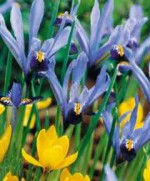
Crocuses are one of the earliest blossoms to greet me in winter sometimes blooming in the snow and ice. They usually don’t bloom for long but every one of them is treasured for its brave and hardy nature. But there can be a down side; the foliage left behind. Cutting it back is not an option if you want the crocuses to return. Like other bulbs they need the foliage to store up food for the next year’s growth and bloom. So there is the dilemma; cut and loose, or leave and have a mess.

For years I struggled with the long grass like foliage of my gorgeous large flowered crocuses. Their bright colored blooms never failed to please and I enjoyed them until the last one faded. Then the trouble began. The foliage elongated slowly so that by June it had fallen over and covered a circle about 8’ around each bulb. By mid June I needed to plant my summer blooming flowers and the mess I faced each year was standing in my way. When I moved I decided to change my tactics and use the smaller flowered species crocuses. They are the very early blooming ones, blooming two weeks or so earlier than their cousins, Crocus vernus, the large flowering ones. They come in a greater assortment of colors, some vivid, others delicate, so that they offer ample opportunities to pair with other early blooming bulbs such as rock garden iris (Iris reticulata). And best of all the grass-like foliage is attractive, less dense, and does not grow longer when the flowers fade. As a bonus, species crocuses are less expensive than the large flowering ones; for example $12.50/100 as compared to $18.50/100. What is not to like about these wonderful early spring gems

P.S. I must confess that although species crocuses and Iris reticulata make beautiful combinations the Iris reticulata has very long foliage after it blooms so you are back to the foliage problem.
